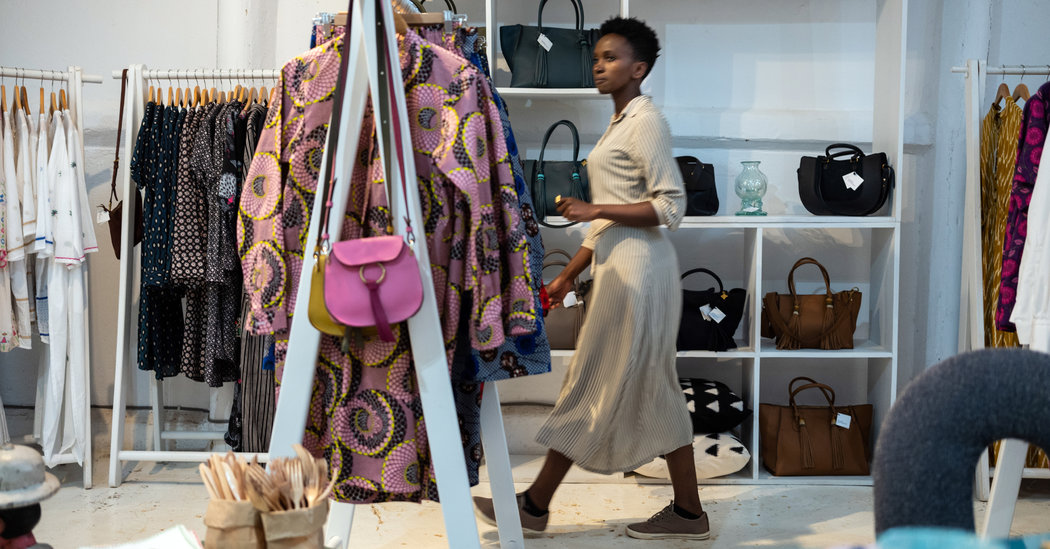
KAREN, KENYA — In this southeastern suburb of Nairobi, the ubiquitous rust-red dirt is kicked up and splattered onto the banana tree leaves by the intense rains that sweep across the hills and by Maasai tribesmen herding their cattle through the roads during rush hour.
Away from the capital, there is space for designers to set up workshops and, green and lush, it offers inspiration for artisans. “When you work at your desk, you see in the garden birds and flowers,” said Gus Chaumont, a Frenchwoman who with her mother, Lilo, run the French-Kenyan interiors brand L’Équipée. “You just cannot get that in a normal office in Nairobi.”
Karen, said to have been named for the Danish writer Karen Blixen, who published works like “Out of Africa” under the pen name Isak Dinesen, has become a home to both expats and wealthy Kenyans, with stately villas and a few five-star hotels for travelers who want to be luxuriously situated close to the airports for safari excursions or beach holidays. It is also home to some of the city’s most intriguing and exclusive places to shop, for items like statement silver jewelry, hand-carved chairs and locally dyed and sewn fashion.
“Karen is an incredibly inventive place,” said Sasha Horner, the director of House of Treasures. “The shopping aesthetic here is creative and of excellent quality. Most of the artisans are renowned for their attention to detail and the use of local labor in collaboration with imported goods to create their pieces, and a lot are eco-conscious too.”
Ms. Horner and her mother, Janet Hurt, decided to open a shop here 19 years ago. Located in a charming garden at 70 Dagoretti Road, the shop, House of Treasures, is both a concept store — they highlight local design and find items for their shop in places like Bali, India, Mexico and South Africa — and something of a mini-mall, where local vendors rent spaces to sell their designs.
One of those vendors is Linda Camm, whose workshop is a stone’s throw from here. She has worked for over three decades with Maasai artisans who create stunning beadwork on leather pillows, ottomans and belts.
Kate Middleton, the Duchess of Cambridge, wore one of her shell belts on a tour of Canada in 2011. In the last few years Ms. Camm has focused much of her own design on mosaic mirrors and painted mirror tiles.
In an annex attached to the main store is the Bush Princess concession, a leather fashion brand founded by the Swedish expat Charlotte Lefebvre 11 years ago. One of the most important aspects of her creations — which include clothing, leather handbags and sandals — is that she, like many other local designers, works with Kenyan artisans to create pieces that in turn help them earn a livelihood.
“Our dyeing and coloring is done locally, all the hardware I source here, aside from zippers, and I work with independent workshops that work with recycled brass,” she said, adding though that because the textile industry in Kenya is so small, she gets much of her cloth from India.
Bush Princess shares its space with L’Équipée, which sells hand-carved chairs with kanga prints and funky sculpted lights in the shape of animals like hippos and giraffes. L’Équipée also does some design work for Kazuri Beads (Mbagathi Road), a nearby shop that employs over 300 women who craft vibrant midsize jewelry.
Across town is the cheery bright boutique and workshop of the designer Anna Trzebinski (94 Tumbili Road), one of the trailblazers here in integrating Maasai beadwork into high fashion products like handbags, suede jackets and Nepalese-woven pashminas. Over the years she has worked with high-end fashion brands like Donna Karan and Paul Smith, and sells her accessories in stores across the United States.
Ms. Trzebinski’s exquisite tiny details set her work apart, with soft- as-a-baby suede bags that include design details like cowrie shells on the handles, or draping shawls trimmed with vibrant peacock feathers sewn onto the ends. “I have been working with the same people for the last 20 years, we are all together still and it’s a bit like a Parisian couture house,” said Ms. Trzebinski, whose daughter, Lana, is also a Karen-based designer and ceramist. “We often have the opportunity and choice to use raw materials that are much cheaper, but we don’t want to because in every single facet of what we do we want to uphold traditional craft.”
Elizabeth Warner, who was born in America and raised in Kenya, infuses a similar vibe into her brand Maasai Collections, which has a small outpost at nearby Langata Link (Langata Road South). Founded in 2002, Maasai Collections sells both the creations of Ms. Warner, who designs jewelry made out of cow horn as well as woven beach bags with beaded straps, but other Kenyan pieces including Kapoeta by Ambica’s feather jewelry and flowing embroidered blouses by Aman Lamu.
Local designers and artisans rent spaces at Langata Link and sell everything from sweet children’s dressing gowns in pastel striped kikoi cloth to velvety skin care products made from macadamia nuts. “It’s pretty cool because you have a mishmash of designers here,” said Ms. Warner.
She was enthusiastic about the high-end crafts and antiques shop Utamaduni, nearby on Langata South Road, which sells hand-carved masks, figurines and statues from across sub-Saharan Africa, as well as items like Ghanaian leather and straw baskets covered in cowrie shells and elaborate antique wooden headrests adorned with silver from Somalia. “They have an enormous collection of things going on at Langata Link. It’s like an African bazaar with eclectic designers all doing their thing.”







